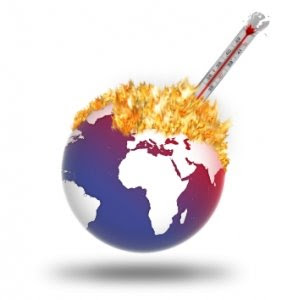
For anyone who listened to our show last Sunday (July 13th), you know that I did a brief monologue on global warming and detailed the differences between the RSS MSU temperature system and data; and the GISS/NOAA system and its data. Until recently, the readings between the two (or three, depending on whether you actually consider the NOAA numbers separate) have been pretty similar.
The GISS (Goddard Institute for Space Studies) is a branch of NASA that is involved primarily with tracking climate data. The NOAA (National Oceanographic and Atmospheric Administration) has, among its other duties, to warn of weather hazards to boaters and news agencies. It should be no surprise that the NOAA also tracks global historical weather data. The sensors these two groups use to gather their temperature data have been a topic of concern lately because they've started to differ substantially from another trusted source - the RSS MSU system.
MSU stands for Microwave Sounding Units and it works by measuring microwaves emitted from the Earth and extrapoling very accurate readings from any part of the Earth (and at any altitude) that it can see at that moment. An ever-growing number of scientists are now proclaiming this to be the most accurate system of all.
Why? Because it's not subject to local influences which could alter the data, that's why. Reports (largely overlooked) have circulated for years that the GISS and NOAA sensor data was being altered by poor implementation. It seems that when the system was put into place in the 60's the original specs set up by the designers called for the sensors to be put into metal boxes coated with a special whitewash that would reflect heat from the sun. In 1978 though, the rules were changed (presumably to save money) to allow the boxes to be painted with white latex paint. Obviously, the paint doesn't reflect the sun's heat nearly as well.
Enter Anthony Watts, a young meteorologist who read about the change and wanted to find out if it mattered. He located where the nearest sensor was and drove out to see it for himself and to his shock, he discovered that the sensor box was at the top of a lightpole in the middle of a parking lot... something that would surely throw the data off. He then watched as the afternoon sun set and the light came on. Since the sensor was directly above it, he concluded (correctly) that the equipment could not possibly be relaying reliable numbers.
To make a long story short, he recruited dozens of people and set up a website at surfacestations.org which he uses to gather measurements on these sensors to determine whether they are being influenced by outside heat sources. As of now, he and his team have surveyed just under half of the stations in the US and a brief rundown of his results is as follows:
* 18% of the stations had a heat source within 30 meters (1 to 2 degrees C variation)
* 56% of the stations had a heat source within 10 meters (2 to 5 degrees C variation)
* 13% of the stations had a heat source within 2 meters (5 to 10 degrees C variation)
* In all, 87% of the stations had a heat source too close for reliability.
I myself would probably have never heard of Anthony Watts & co. if it were not for new information coming to light revealing that the MSU numbers for 2007 differed from those of the GISS/NOAA data set. While the latter ranked 2007 as being tied with 1998 as the 2nd warmest year in the past decade, the MSU numbers ranked it as only 9th. It was this disparity that caused climatologists around the world to take a second look.
Here's the yearly temperature average rankings:
| 1998 | 1999 | 2000 | 2001 | 2002 | 2003 | 2004 | 2005 | 2006 | 2007 | |
| RSS MSU: | 1st | -- | -- | 7th | 3rd | 4th | 6th | 2nd | 5th | 9th |
| GISS/NOAA: | 2nd | -- | -- | 7th | 3rd | 4th | 6th | 1st | 5th | 2nd(tied) |
The real story here however should be that the Earth is actually cooling (or at least plateaued) when you look at the graph for the past 10 years. Skeptics will naturally declare that 10 years is an unreasonable sample size and that not too much should be read into that. Keep in mind though, that we're told the Earth is warming based on a sample size not much greater; 23 years by the scientific community's reckoning.
But is a little over decades of warming even a trend? The story of the 20th century tells us that this has happened before and it will happen again. From 1918 to 1940 we had a warming trend about like the one we've seen recently, and from 1940 to roughly 1965 it cooled. A plateau of cool stability then carried us through the mid-70's until we began the latest upward temperature trend.
Check back soon - I'll have a part 2 on global warming ready in a week or so.
- Scott
